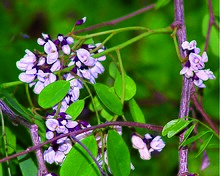Dalbergia lanceolaria
Appearance
(Redirected from Lanceolarin)
| Dalbergia lanceolaria | |
|---|---|

| |
| Scientific classification | |
| Kingdom: | Plantae |
| Clade: | Tracheophytes |
| Clade: | Angiosperms |
| Clade: | Eudicots |
| Clade: | Rosids |
| Order: | Fabales |
| Family: | Fabaceae |
| Subfamily: | Faboideae |
| Genus: | Dalbergia |
| Species: | D. lanceolaria
|
| Binomial name | |
| Dalbergia lanceolaria | |
| Synonyms | |
Dalbergia lanceolaria is a species of tree in the subfamily Faboideae and tribe Dalbergieae.[2] It is a medium-sized tree growing to 20m tall[3][4] and is native to: India, Sri Lanka, Nepal, Burma[4] and Indo-China.[3]
The bark of the tree is traditionally used as an analgesic and anti-diarrhoeal.[5] The apiose isoflavone compound lanceolarin is found in its root bark.[6]
Because it produces new stems (ramets), it is recommended for reforestation projects on degraded land where seeds are unlikely to grow successfully.[7]
Subspecies
[edit]Plants of the World Online includes:[8]
- D. lanceolaria var. errans (Craib) Niyomdham - Indo-China
- synonym: D. errans Craib
- D. lanceolaria var. lakhonensis (Gagnep.) Niyomdham & P.H.Hô - Indo-China
- synonyms: D. lakhonensis Gagnep, D. lanceolaria var. maymyensis (Craib) Thoth, D. maymyensis Craib
- D. lanceolaria subsp. paniculata (Roxb.) Thoth. - Indian Subcontinent to Indo-China
- synonyms include: Amerimnon paniculatum (Roxb.) Kuntze, D. hemsleyi Prain, D. paniculata Roxb.
Gallery
[edit]References
[edit]- ^ Barstow, M. (2022). "Dalbergia lanceolaria". IUCN Red List of Threatened Species. 2022: e.T150284719A152201877. Retrieved 23 January 2023.
- ^ Roskov Y.; Kunze T.; Orrell T.; Abucay L.; Paglinawan L.; Culham A.; Bailly N.; Kirk P.; Bourgoin T.; Baillargeon G.; Decock W.; De Wever A. (2014). Didžiulis V. (ed.). "Species 2000 & ITIS Catalogue of Life: 2014 Annual Checklist". Species 2000: Reading, UK. Retrieved 26 May 2014.
- ^ a b Phạm Hoàng Hộ (1999) Cây Cỏ Việt Nam: an Illustrated Flora of Vietnam vol. I publ. Nhà Xuẩt Bản Trẻ, HCMC, VN.
- ^ a b "Dalbergia lanceolaria", India Biodiversity Portal, retrieved 11 December 2015
- ^ Kale, M.; Misar, A.V.; Dave, V.; Joshi, M.; Mujumdar, A.M. (2007), "Anti-inflammatory activity of Dalbergia lanceolaria bark ethanol extract in mice and rats", Journal of Ethnopharmacology, 112 (2): 300–304, doi:10.1016/j.jep.2007.03.024, PMID 17442513
- ^ Rao, P.S.; Asheervadam, Y.; Khalilullah, M.; Murti, V.V.S. (1989), "A revised structure for the isoflavone lanceolarin", Phytochemistry, 28 (3): 957–958, doi:10.1016/0031-9422(89)80157-8
- ^ Pandey, S.K.; Shukla, R.P. (2001), "Regeneration strategy and plant diversity status in degraded sal forests" (PDF), Current Science, 81 (1): 95–102
- ^ "Plants of the World Online". Retrieved 16 October 2020.
External links
[edit] Media related to Dalbergia lanceolaria at Wikimedia Commons
Media related to Dalbergia lanceolaria at Wikimedia Commons Data related to Dalbergia lanceolaria at Wikispecies
Data related to Dalbergia lanceolaria at Wikispecies





